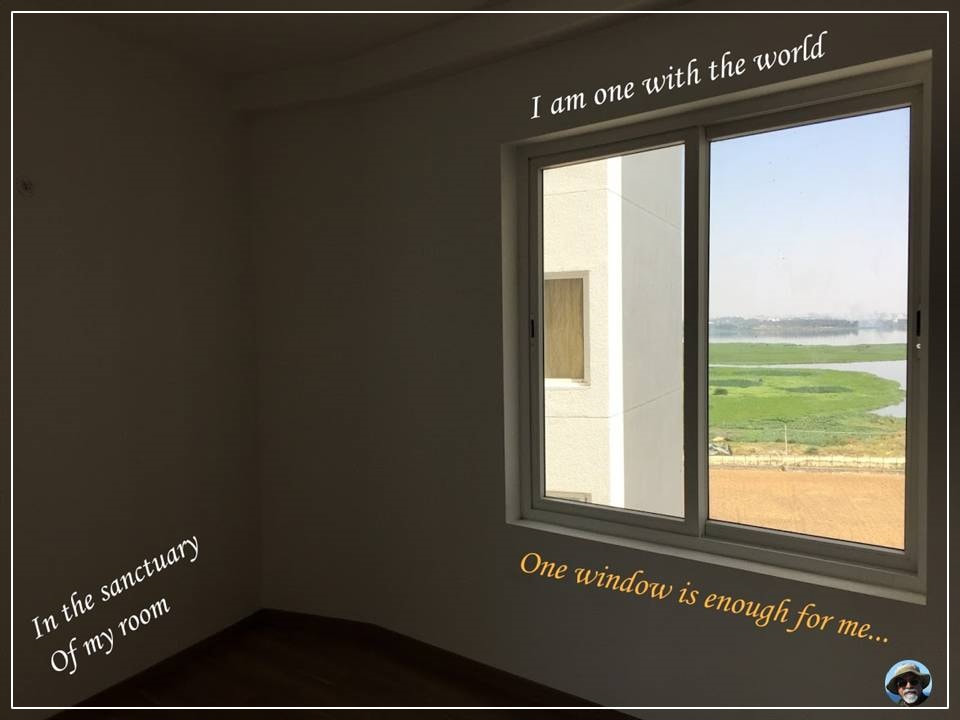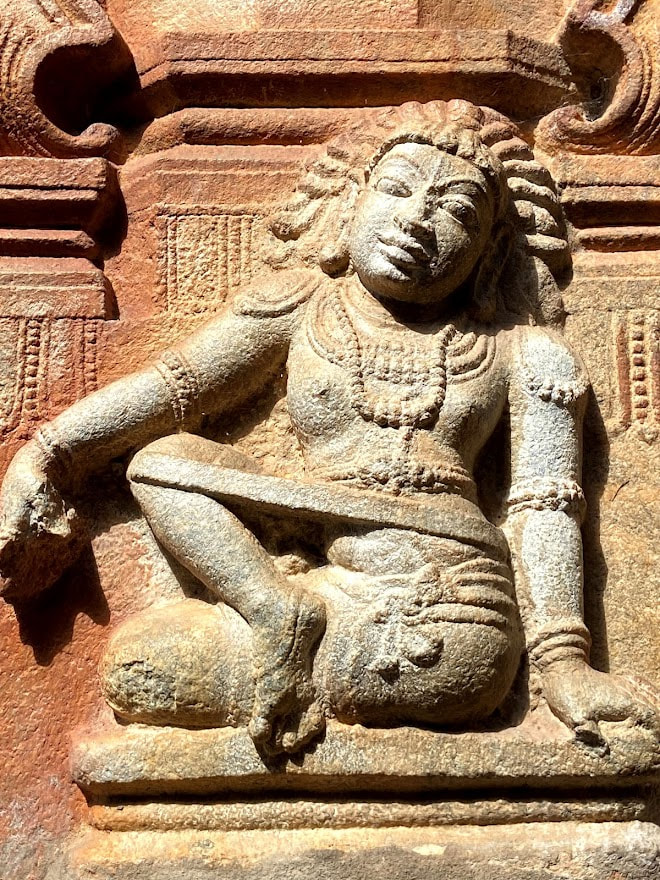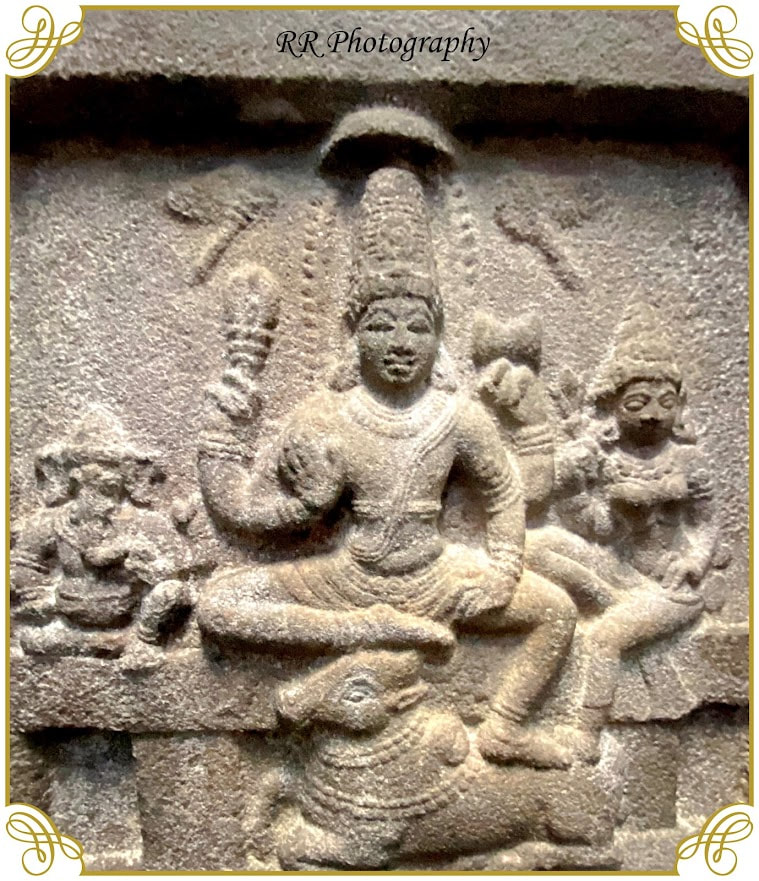|
Over the past year, thanks to the invasion of the virus, I have been spending much of my time at home, working on the computer including consultations with clients and keeping myself busy with reading and writing. We live in a high rise apartment complex and all the flats have huge glass windows. As I write this, sitting beside the window, a bank of clouds appears on the horizon, inching slowly across the sky, finally slipping across and blocking out the fading light of the sun. The lights come on inside the apartments and the windows illuminated by it, create a fascinating collage of colors much like a cubist painting. In that unfolding canvas I sense the palpating life around.
The wonder of the window is not in itself but in the view it offers. Gazing out of my window, my thoughts are adrift on the breeze, that gently caresses the nodding flowers and rustling leaves. I can sit by an open window for hours and hear only bird songs, and the rustle of leaves. There is always something beyond the window. I find myself fascinated by windows. They come in varied sizes and styles and are ubiquitous aspects of every building that makes up our cities and everyday life. They allow us to engage visually with the world from the comforts of our homes while protecting us from the elements. The window is to look outside but it is also to look within. When the window is open, light comes in which can metaphorically illuminate the darkness in the inner recesses of our souls. They are harbors from which the self sails away into unknown expanses and are important intermediaries between the inner and outer world. As Rumi commented, there is a window from one heart to another heart. This intimate relation between the window, seeing, and perception has become part of everyday language: the eyes are often considered as windows to the soul. The notion of seeing is already implied in the term window itself, which derives from the Middle English vindauga, eye of the wind. The history of glass windows is quite interesting. Glassmaking was very much an Eastern skill, and glass-making traditions were well established in many countries in the Middle East, including Egypt, Palestine and Syria. Islamic glassmakers didn’t have any great presence in the West until the capture of Constantinople in 1204 by the Crusaders on their 4th Crusade. This resulted in an influx of fleeing Byzantine glassmakers into Venice bringing with them skills and techniques that were totally new to Europe. By the end of the century, Venetian glassmakers had adapted many of these imported processes, alongside their own, to produce relatively large and transparent glass, referred to as Venetian windows. Windows have lent themselves to artistic expression in multiple ways. Artists have used windows as a framing device to direct our gaze to a particular scene or subject, letting us understand the beauty they saw in a particular scene. Open Window, Collioure is one such example where Matisse beckons us towards the window which looks out onto the idyllic scene of a small fishing port. The bold color palette, reflects the liberation and serenity the artist felt while staying on the Mediterranean coast, a place which soothed his depression with its vitality and vivid colors. “The atmosphere of the landscape and my room are one and the same," said the artist. Vermeer used the play of light streaming through the window in many of his paintings to convey radiance and hope. In Girl Reading A Letter At An Open Window, ethereal light courses through the open windows, lending the picture a transcendent, spiritual glow. With the versatility of their appearances in works of art, it would not be an overstatement to say that the windows in art are windows to the world. As I had mentioned earlier, a window is a portal, allowing one’s thoughts to roam around freely. One of the best narrative to illustrate this in English literature is Forster’s A Room With A View. As the name implies the story essentially revolves around a window and the view it offers. The book outlines the aspirations of the main protagonist, Lucy Honeychurch as she struggles between strict, old-fashioned Victorian values and newer, more liberal mores. A trip to Italy opens her sheltered eyes to ideas and people unlike those she has known growing up in the Victorian countryside. In Florence, she is given a room that looks into the courtyard rather than out over the river Arno. She is quite unhappy with it. Sensing her discontent, Mr. Emerson, a fellow guest, generously offers to exchange it with another one that offers a view of the river. The Florentine window provides her with beautiful vistas of the landscape outside. Lucy’s desire for a room with a view is a metaphor for her longing to connect with Italy and the new experiences the country offers. The window opening out into Florentine symbolizes Lucy’s openness to a new world, which is starkly different from the repressive Victorian mores that she is accustomed to. The Covid virus has heightened our vulnerabilities. Our lived worlds have adapted and changed according to the waxing and waning of the virus. We have been told to isolate ourselves to prevent the infection from outside. As we shut the door and feel secure, the windows offer us an opportunity to engage with the world beyond our four walls, visually and emotionally. As I lose myself observing the world outside, there is no distinction between me and the space around me. I absorb the sounds and sights that envelop me as I look outside the window. In the words of my favorite poet, Billy Collins… The birds are in their trees, and the poets are at their windows. Which window it hardly seems to matter though many have a favorite, for there is always something to see- a bird grasping a thin branch… Look forward to your reflections…comments…
44 Comments
It had rained heavily the previous night. Lightning and thunder kept us awake for most of the night. Undeterred, we woke up early the next day and headed towards Avani in Kolar district. There was an unusually heavy fog for most of the distance. Fortunately as we reached the outskirts of the town, the sun peeped through the clouds and the sky cleared up.
The first sight of the temple at Avani can be deceptive. There is no towering gopuram at the entrance and it is comparatively small in size. But once you enter, you are overwhelmed with its sheer beauty. Sri Ramalingeshwara temple is steeped in antiquity and enveloped in mythology. The temple was built in 10th century, when the Nolamba dynasty was in power. The Nolambas ruled from the 8th to the 12th centuries C.E, over an area called Nolambavadi which extended over south-east Karnataka and parts of Tamil Nadu and Andhra Pradesh. Hemavati was the capital of the Nolambas. They built many spectacular temples but unfortunately very few history books mention about them. They flourished under Rashtrakuta tutelage, but after their collapse they were overrun by the Ganga King Marasimha, who called himself Nolambakulantaka after vanquishing the Nolamba royalty. The walled courtyard resembles the Bhoganandeeshwara temple complex at the foot of the Nandi Hills, which was also built by the Nolamba kings. Inside the temple precincts, there are shrines named after Rama, Lakshmana, Bharata and Shatrughna as also for Vali and Sugriva. Each of these shrines has a Shivlinga. The Ramalingeshwara, Lakshmanalingeshwara and Shatrughanlingeshwara shrines stand adjacent to each other. The Ramalingeshwara is the central one and is also the main temple which is still in worship. The Bharatalingeshwara shrine lies on the other side of the temple premises. We started with the Ramalingeshwara shrine. The exquisitely decorated linga lit by a few oil lamps in the dark garbhagriha had an ethereal impact enhanced by the sonorous voice of the priest chanting the mantras. He briefly outlined the sthalapurana of the place and the significance associated with it. It was nice to know that his son was learning the vedas and after completing BA in Sanskrit would continue the legacy of the family. After spending some time in his company we started exploring other shrines in the complex. The shrines of Lakshmanalingesvara and Bharatalingeshwara are the most ornate. The ceiling of both of them have superbly carved figures of Uma Mahesvara surrounded by the Ashta Dikpalakas, divine guardians of eight directions of the universe. Each one of them is depicted on their vahanas: Indra on elephant, Agni on goat, Yama on buffalo, Nirurti on horse, Varuna on crocodile, Vayu on deer, Kubera on Man, Isana on bull. The pillars have intricate relief sculptures. The entrance to both these shrines have elaborately carved doorways. The outer walls of the shrines are decorated with delicate carvings and graceful sculptures of various Hindu gods. The Chola and Vijayanagara rulers have added various elements to the original Nolamba structure. In one corner of the temple, the figure of a boar, the emblem of the Vijayanagara empire, is carved on the wall! A small hill, strewn with boulders forms an interesting backdrop to this ancient temple. It is believed that Sita retreated to this hill after her trial by fire and gave birth to Lava and Kusha who grew up in the hermitage of Valmiki. Avani means earth and Sita is also referred to as Avanisuta, daughter of earth. There is a temple devoted to Sita and Parvathi on top of the hill as also various caves. One of them is believed to be the ashram of Valmiki. The mud there is reported to have medicinal properties and people take it, mix it with water and drink it to cure illnesses. The village of Avani attained prominence due to the legends associated with it. It is said to be the site of Uttara Ramayana. When Rama performed the Ashwamedha Yagna, the ceremonial horses were left to wander freely. When the horses reached Avani, Lava and Kusha challenged the authority of Rama, not realizing that he was their father. Rama sent his brothers Bharata, Shatrugna and Lakshmana all of whom were defeated in the battle. Then Rama himself went and fought against Lava and Kusha till Valmiki told him that they were his sons and aborted the battle. The shivalingas, which are named after them, were installed by Rama and his brothers to beg forgiveness from Lord Shiva for fighting with Lava and Kusha. It is quite amazing to note how stories from the Ramayana are woven into the collective memory of people across India and through their association with temples like the one at Avani. The temple at Avani is sheer poetry in stone. Every verse of it has been carefully and lovingly crafted by talented artisans who unfortunately remain unnamed. Faces, forms, textures and designs come alive through their chisels. Timeless sculptures Tell tales From ancient stones You can become part of them If you melt into them… Glimpses At: photos.app.goo.gl/B2HHxHVLSCV3B9q8A Feel free to post your comments here! Often when we visit temples, we head straight to the sanctum sanctorum to have a darshan of the main deity. In our hurry, we fail to notice myriad intricate sculptures carved into the pillars and the ceiling.
For example, images of ashtadikpalakas can be seen in many temples on the ceiling of the central pavilion (Māhamandapa) facing the main deity. One of the best preserved friezes of these images is at the temple at Avani, Kolar district. There are superbly carved figures of Uma Mahesvara surrounded by the Ashta Dikpalakas, divine guardians of eight directions of the universe. Each one of them is depicted on their vahanas: Indra on elephant, Agni on goat, Yama on buffalo, Nirurti on horse, Varuna on crocodile, Vayu on deer, Kubera on Man, Isana on bull. Ashta means eight, “dik” means quarters or directions and ”pālas“ means rulers. As their collective name suggests, they rule the eight quarters or the eight directions of the universe and act as their chief guardian spirit. When we make an atma-pradakshina (revolving around one self) in front of God, we are not only saluting the self with in, the God in front, but also these divinities that are around us in all directions. As guardians of the sky, Ashtadikpalakas watch over us from eight different directions and keep an eye on all our activities as we enter the temple! It is also interesting to note that there are no goddesses among them, just as there are none in the navagrahas too! Horoscopes continue to play a major role in arranged marriages in India. Number eight plays a crucial role in that too! Marital compatibility in horoscopes is assessed on eight parameters. Each of the parameters gives a certain amount of marks, adding up to 36 marks. If the couple has at least 18 marks, it is considered safe to proceed! The number eight also figures when we offer Saashtaanga Namaskaaram. Sa means with, Ashta means eight and Anga means limbs, Namaskara means prostration. Saashtaanga Namaskaara means, reverential prostration performed with eight limbs (Ashta-Anga) viz. two hands, two legs, two arms, chest and forehead touching the ground as a mark of respect, obeisance and total surrender to the deity. Of course, God is everywhere and in every direction. In whatever direction you proceed or offer your prayers, you will ultimately find Him. There is a famous story of a saint stretching his feet in the direction where there was a god’s statue. When people objected to it, he asked them to show the direction where God was not present, emphasizing the omnipresence of God. If you look carefully, symbol for infinity is like an 8 on its side! Glimpses At: photos.app.goo.gl/XjFtWxE7xFfYknMy5 Feel free to post your comments here! |
Dr Raguram
Someone who keeps exploring beyond the boundaries of everyday life to savor and share those unforgettable moments.... Archives
May 2024
Categories |



 RSS Feed
RSS Feed